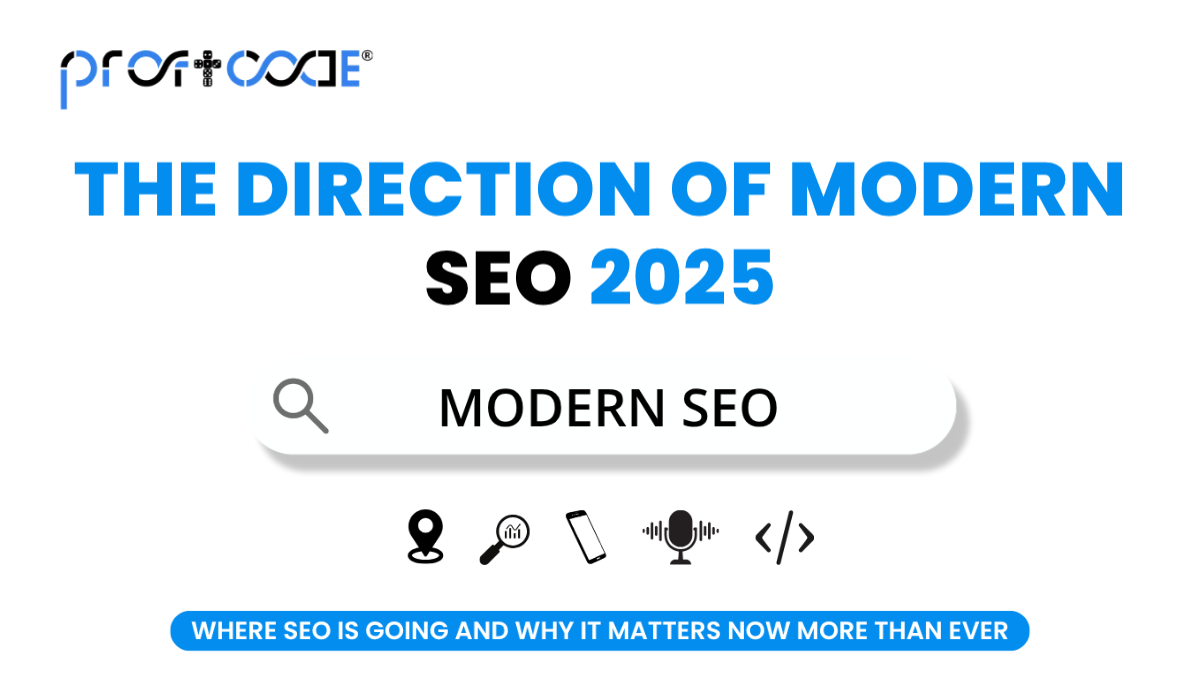In 2025, Search Engine Optimization (SEO) has evolved far beyond keyword stuffing and basic link-building, becoming a sophisticated blend of user intent, advanced technology, and ethical practices. According to At Proftcode, the digital landscape demands a focus on user experience, seamless technical integration, and sustainable strategies for businesses to succeed. Here are five key SEO trends shaping 2025 and 2026, paired with practical strategies to ensure long-term success in this dynamic environment.
Five Modern SEO Trends for 2025 & 2026
1. User Experience (UX) as a Core Ranking Factor:
User experience is now a pivotal SEO driver. Search engines like Google prioritize websites offering seamless, engaging, and intuitive interactions. Core Web Vitals—metrics like Largest Contentful Paint (LCP), First Input Delay (FID), and Cumulative Layout Shift (CLS)—are critical, assessing page load speed, interactivity, and visual stability. These directly influence user satisfaction and rankings.
Beyond metrics, UX includes intuitive navigation and accessibility. With over 60% of global searches originating from mobile devices, mobile-friendliness is essential. Accessibility features like alt text for images and keyboard navigation also boost inclusivity, which search engines favor.
Insights: At Proftcode, Conduct UX audits using tools like Google Lighthouse or PageSpeed Insights to pinpoint performance issues. Optimize for responsive design and eliminate intrusive pop-ups. A 1-second delay in load time can cut conversions by 7%, so prioritize speed to enhance rankings and revenue.
2. Voice Search and Conversational Queries:
The rise of smart speakers and assistants like Siri and Google Assistant has made voice search a game-changer. By 2025, nearly 50% of searches are expected to be voice-driven, characterized by longer, question-based, and local queries (e.g., “Where’s the nearest coffee shop?”). Unlike text searches, voice queries demand conversational content.
To optimize, focus on long-tail keywords, question-based phrases, and structured data to improve visibility in voice results. Schema markup, such as FAQs or How-To schemas, helps search engines prioritize content for voice responses.
Insights: At Proftcode, develop FAQ pages or blogs targeting question-based keywords (e.g., “How to optimize SEO in 2025?”). Use natural, conversational, and implement structured data via Schema.org or Yoast SEO. Test content discoverability by querying devices like Google Home.
3. Context-First Algorithms:
Search engines now emphasize user intent over exact-match keywords, making context-first algorithms central to SEO. These algorithms analyze user behavior, location, device, and past interactions to deliver personalized results. Success requires content aligned with user intent—informational, navigational, or transactional—using natural language and semantic relevance.
This shift demands deep audience research and tools like natural language processing (NLP) to optimize for conversational queries and long-tail keywords, especially for voice search.
Insights: At Proftcode, leverage proprietary analytics to decode user intent through behavioral and semantic data. Use AI-powered keyword clustering and sentiment analysis to craft resonant content. Perform regular technical audits and track performance in real-time to adapt to algorithm updates and stay competitive.
4. Video and Visual Search:
Video content dominates in 2025, with platforms like YouTube and TikTok driving significant search traffic. Google’s integration of video results into SERPs makes video optimization crucial. Visual search, powered by tools like Google Lens, also creates opportunities, especially for e-commerce.
For video SEO, optimize titles, descriptions, and tags with relevant keywords, and include transcripts for accessibility. For visual search, use high-quality images with descriptive alt text and structured data like product schema.
Insights: At Proftcode, host videos on YouTube for reach but embed them on your site to drive traffic. Use VidIQ for keyword research and YouTube Analytics to refine strategies. For visual search, ensure high-resolution product images are tagged with schema markup and validated with Google’s Rich Results Test.
5. Zero-Click Searches and Featured Snippets:
Zero-click searches, where answers appear directly on the SERP, are increasingly common. By 2025, over 40% of searches are projected to be zero-click, driven by featured snippets, knowledge panels, and rich results. Optimizing for position zero is critical.
To capture snippets, structure content to answer questions concisely using paragraphs, bullet points, or tables. Target long-tail, question-based keywords and use schema markup to boost eligibility.
Insights: At Proftcode, analyze competitors’ snippets with tools like Ahrefs or SEMrush to identify gaps. Create scannable content (e.g., “Top 5 SEO Trends for 2025”) with clear header tags (H2, H3). Monitor snippet performance in Google Search Console to track impressions and clicks.
Technical SEO: The Foundation of Success
Technical SEO underpins effective strategies in 2025, covering site speed, mobile optimization, crawlability, and security. Key practices include:
- Site Speed: Compress images, use browser caching, and leverage CDNs to reduce load times.
- Mobile Optimization: Ensure responsive design and test usability with Google’s Mobile-Friendly Test.
- Crawlability: Maintain clean sitemaps and robots.txt files for search engine bots.
- Security: Use HTTPS and audit for vulnerabilities regularly.
Optimize for Google’s mobile-first indexing and implement structured data. Tools like Screaming Frog or Sitebulb help identify issues like broken links or duplicate content.
Insights: At Proftcode, schedule monthly technical audits with GTmetrix for speed analysis and implement fixes like lazy loading. Validate structured data with Google’s Rich Results Test to maximize SERP visibility.
Data-Driven SEO Strategies
Data fuels modern SEO. Tools like Google Analytics 4, Search Console, and Ahrefs provide insights into traffic, keywords, and engagement. Key practices include:
- Keyword Analysis: Identify high-value keywords with SEMrush or Moz.
- User Behavior: Track dwell time and click-through rates to assess content performance.
- Competitor Analysis: Benchmark competitors to uncover opportunities.
Insights: At Proftcode, build custom Google Analytics dashboards to monitor KPIs like organic traffic and conversions. Use A/B testing for on-page elements and review Search Console reports to adapt to query trends.
Ethical SEO for Sustainable Growth
Ethical, or “white-hat,” SEO prioritizes sustainable practices aligned with search engine guidelines. Google’s algorithms in 2025 adeptly detect manipulative tactics like keyword stuffing or paid backlinks. Key ethical practices include:
- Quality Content: Produce original, valuable content addressing user needs.
- Transparent Link-Building: Earn backlinks via outreach or guest posting.
- Compliance: Follow Google’s Webmaster Guidelines to avoid penalties.
Insights: At Proftcode, foster relationships with influencers for organic backlinks. Publish research-backed content to build authority. Stay updated on algorithm changes to ensure compliance.
Final Thoughts
In 2025, SEO is a user-centric, dynamic discipline blending voice and visual search, ethical AI, zero-click strategies, and robust technical practices. Sustainable success relies on trust-building through ethical, data-driven approaches. At Proftcode, we emphasize real-time analytics, AI-enhanced content, and proactive adaptation to algorithm shifts, empowering businesses to thrive in 2025 and beyond.






